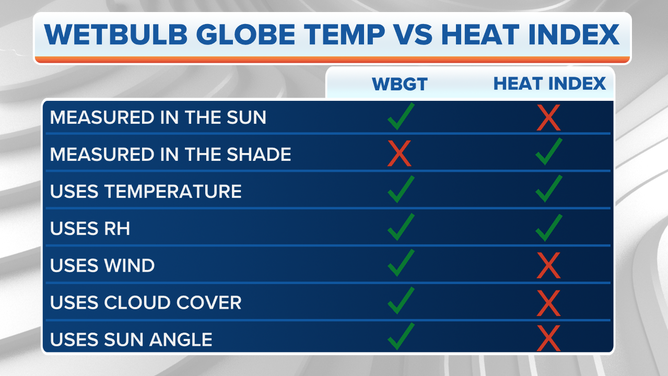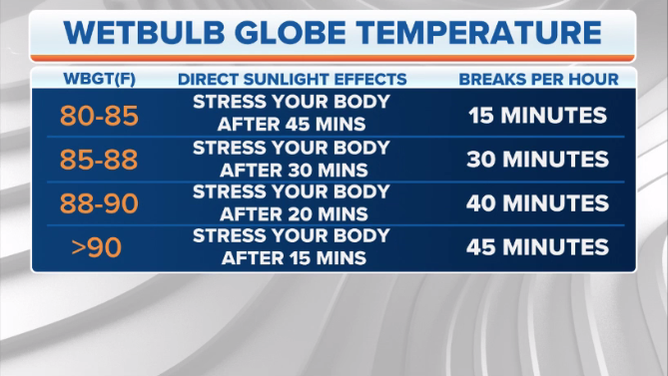What is the wet-bulb globe temperature and why do you need to know about it?
The wet-bulb globe temperature should be used in conjunction with the heat index to keep you safe in excessively hot weather
How to tell the difference between heatstroke and heat exhaustion
The two heat-related illnesses can appear very similar, but have dangerously different outcomes.
You might already be familiar with the heat index, but there’s another way meteorologists classify how the weather actually feels to the human body: the wet-bulb globe temperature, or WBGT.
While the temperature and heat index are measured in the shade, the WBGT is a measure of the heat stress in direct sunlight. Both the heat index and WGBT account for temperature and humidity, but the WGBT also accounts for wind speed, sun angle and cloud cover (solar radiation), according to the National Weather Service.
"If you work or exercise in direct sunlight, this is a good element to monitor," the NWS said. "Military agencies, OSHA (Occupational Safety and Health Administration) and many nations use the WBGT as a guide to managing workload in direct sunlight."

Wet-bulb globe temperature vs. heat index.
(FOX Weather)
During outdoor sports practices or games, it’s important to know the WBGT so that any players exposed to hot temperatures in direct sunlight will not put a dangerous amount of stress on their bodies. It can also be a guide to the coaches, indicating how often they need to schedule breaks and hydration for their players.
For example, if the WBGT is below 80 degrees, the NWS says no extra precautions are necessary. But if the WBGT is between 80 and 90 degrees, working or exercising in direct sunlight will stress your body after 20 to 45 minutes, requiring 15 to 40 minutes of breaks in the shade each hour.
Once the WBGT exceeds 90 degrees, the body will become stressed after just 15 minutes if working or exercising in direct sunlight, and the NWS advises taking at least 45 minutes of breaks in the shade each hour.

This table breaks down the heat impacts that can be expected at various wet-bulb globe temperatures.
(FOX Weather)
Both the WBGT and the heat index are useful measurements to keep you safe in excessively hot weather. If you plan to spend most of your time in the sun, use the WBGT to determine how frequently you should take breaks. If you expect to be mainly in the shade, the heat index is a better measure of the potential of heat-related stresses on your body.
While it may seem like the WBGT is relatively "cool" compared to the heat index, the two calculations do not use the same temperature scale because they account for different types of weather conditions. A WBGT over 90 degrees can be deadly if proper precautions are not followed.
The NWS office in Tulsa, Oklahoma, has a calculator at this link, which allows you to determine the WBGT at your location based on the current or forecast weather conditions, time of year and latitude.
